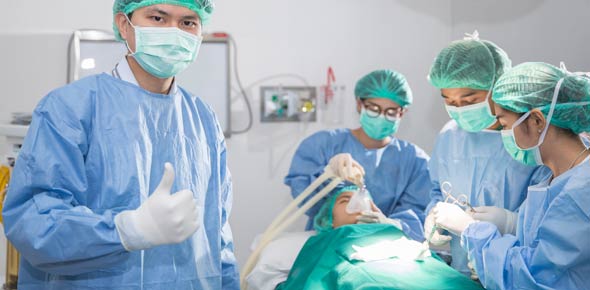Circumcision refers to
Stones removed during surgery should be sent to the laboratory
Continuous irrigation following TURP is accomplished by use of a
Why is the table straightened before closing a kidney incision?
Nonmalignant enlargement of the prostate is termed
Removal of a testis or the testes is called
Kidney stones are sent to the lab in
The most widely used method of scar revision next to scar removal is
An anticoagulant given for its antagonistic effect on heparin is
The procedure of choice for removal of a foreign body in a child's...
The Pereyra needle is used in which specialty area of surgery?
Orchiopexy can be defined as
The purpose of the kidney elevator is to
The procedure to treat organic sexual impotence is
To prevent thrombi from forming in the walls of the renal vein during...
The three lumens of a Foley are used for inflation, drainage, and
Rib removal for surgical exposure of the kidney requires all of the...
A needle biopsy of the prostate may be accomplished with a (n)
A lumbar or simple flank incision for ureter or kidney surgery may...
An abnormal accumulation of fluid in the scrotum is to a (n)
Plaque removal from a vessel is termed
Urethral meatal stenosis is corrected by a (n)
Retraction of fine structures and blood vessels during vascular...
Pedal pulses are assessed with a
A staghorn stone is one that lodges and continues to grow in the
What instrument is used to view lymph nodes or masses in the space...
Microscopic reversal of the male sterilization procedure is termed
Why is a 30-cc bag Foley used after a TURP?
Penile condylomata are most successfully removed by
Which drug can be added to saline for irrigation during a vascular...
In which procedure could a Fogarty catheter be utilized?
Which solution is NOT used during a transurethral prostatectomy?
Bladder stones are crushed with a
Which muscle is utilized to effect a TRAM flap in breast...
A cytologic specimen collector used in bronchoscopy is
Migrating clots that have formed in the lower extremities can be...
In a penile implant, the inflation pump is located in the
The prime consideration in a ruptured abdominal aortic aneurysmectomy...
A Pereyra procedure is done for
Dextran is used parenterally to
In cystoscopy, the irrigating solution is
Which anomaly is corrected by the MAGPI procedure?
Which piece of equipment would be placed on an embolectomy setup for...
The antagonist to heparin sodium is
All of the following procedures may be completed through a cystoscope...
The use of distilled water during a highly invasive genitourinary...
The tube that collects bronchial washings is
Heparin is utilized during vascular surgery
An endoscopic procedure to treat stress incontinence is a
Which vessels are harvested for a coronary artery bypass?
The term used to denote the function accomplished by the...
Extracorporeal shock wave lithotripsy (ESWL) disintegrates stones by...
Which suture would be used on an aortic valve replacement?
All of the following are ideal requirements of cadaver donors EXCEPT
Urethral strictures can be dilated by use of each of the following...
A reduction of negative pressure on one side of the thoracic cavity...
The goal of a carotid endarterectomy is to
In which surgery would a tunneler be used?
If a knitted graph is preclotted, it
A percutaneous nephrolithotomy utilizes all of the following EXCEPT
Before insertion of a penile implant, the insertion site, as well as...
The intraoperative diagnostic test that measures tissues perfusion is
The action to be followed if a patient is experiencing a cardiac...
Cooling and flushing of pancreas, liver, and kidneys of cadaver donors...
How many anastomoses must be completed to effect a single-lung...
When the male penis is curved ventrally with the meatus and the glans...
Surgical removal of fibrrinous deposits on the visceral and parietal...
What cold solution is used to preserve a donor lung before trasplant...
All of the following are true regarding disposable chest drainage...
Which ureteral catheter is used to dilate the ureter?
What instrument is used to reapproximate the ribs following an...
Nonconducting, isomotic glycine irrigating solution must be used in...
When the prostate gland is removed through an abdominal insicion into...
Hypothermia is employed in cardiac surgery
Laser lithotripsy utilizes the tunable pulse-dyed laser known as
Amputated extremities are
Abdominal resection of the prostate gland through an incision into the...
In creating a continent urinary diversion postcystectomy, all of the...
What is the alternative approach to surgical TURP that has resulted...
In balloon angioplasty, the dilating balloon is inflated with
Which of the following is NOT considered a permanent urinary...
Following anastomosis of a ureter during a ureteral reimplantation...
Temporary diversion of urinary drainage by means of an external...
Compression of the subclavian vessels and the brachial plexis usually...
After incision is made into the scrotum during a vasectomy, the...
A reverse sterilization procedure in the male is called a (n)
What substance is introduced through a thoracoscope to deal with...
Which of the following would be the suture of choice for a...
The most common vessels used for access procedures to facilitate...
An alternative approach to surgical TURP utilizing a cystoscopic setup...
Bladder drainage that diverts urine away from the urethral vaginal...
The combined correction of a redundant renal pelvis and resection of a...
Passage of a sterile catheter into the heart via the brachial or...
Placement of a vascular graft proximal to and inclusive of the common...
The drug of choice for adequate diuresis of a living donor before...
The laser used to destroy small recurrent bladder tumors is the
A cardiopulmonary technique that employs the principle of...
Decompression of the portal circulation can be achieved by all of the...
Excision of the tunica vaginalis is a
Fluoroscopy is required for all of the following vascular procedures...
















